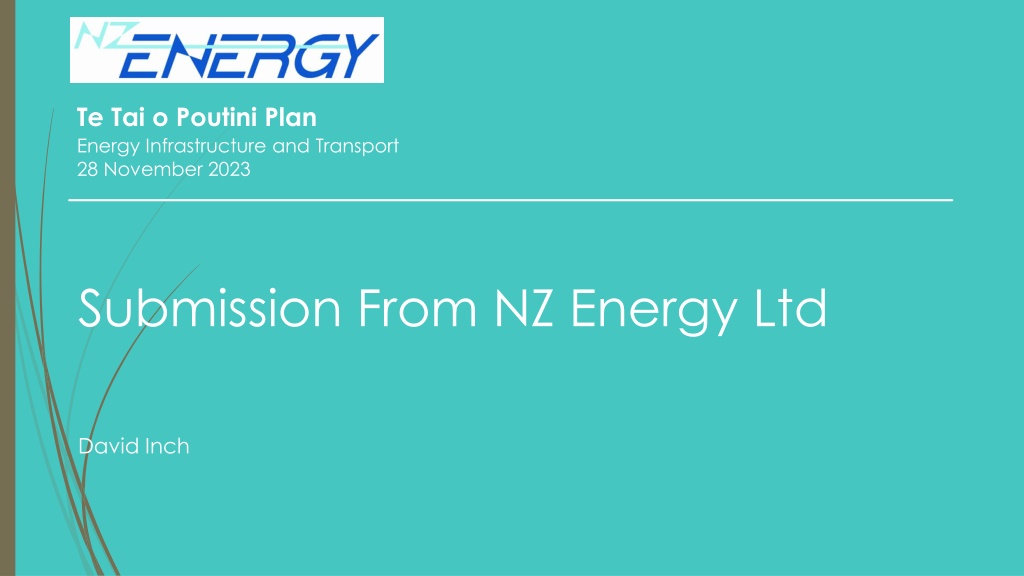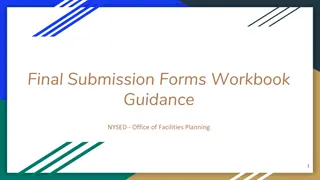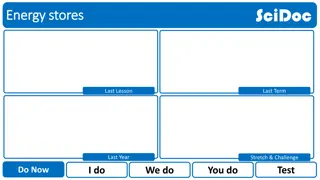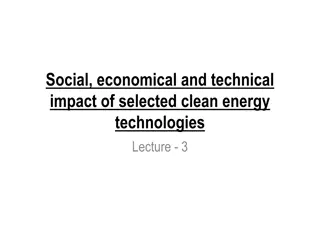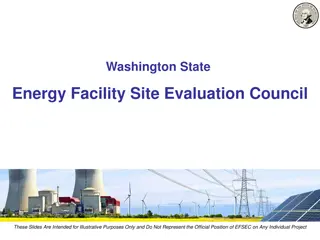Submission From NZ Energy Ltd
NZ Energy Ltd, with existing hydroelectric stations in South Westland, outlines the impact of the planning framework on its operations and future renewable energy proposals. The company owns and operates distribution lines and radio repeater sites, playing a vital role in supplying electricity to remote communities like Haast and Fox. The submission details the need for additional hydro schemes to meet growing energy demands and improve resilience in the face of natural disasters. Find out how NZ Energy supports the objectives and policies of the Te Tai o Poutini Plan.
Download Presentation

Please find below an Image/Link to download the presentation.
The content on the website is provided AS IS for your information and personal use only. It may not be sold, licensed, or shared on other websites without obtaining consent from the author.If you encounter any issues during the download, it is possible that the publisher has removed the file from their server.
You are allowed to download the files provided on this website for personal or commercial use, subject to the condition that they are used lawfully. All files are the property of their respective owners.
The content on the website is provided AS IS for your information and personal use only. It may not be sold, licensed, or shared on other websites without obtaining consent from the author.
E N D
Presentation Transcript
Te Tai o Poutini Plan Energy Infrastructure and Transport 28 November 2023 Submission From NZ Energy Ltd David Inch
Background NZE - three small hydroelectric power stations in NZ. Two are located in South Westland. Existing Schemes at Fox Glacier and the Turnbull River near Haast. Also involved with other small hydro s and proposals. Griffin Creek, Harold Creek, Littleman Creek and extensions to the current Turnbull Hydro Electric Scheme NZE also owns and operates distribution lines and radio repeater sites. From our experience the planning framework such as proposed in the TTPP influences and impacts on the ongoing operation and costs associated with our existing business and, the development of future renewable energy proposals.
Station is owned by NZ Energy along with the reticulation network in the Haast area. - NZ Energy: Turnbull Haast is NOT connected to NZ s transmission grid. Electricity generated from this Hydro is the sole source of the reticulated power for Haast. Relies on the Diesel backup only for fault restoration and hydro maintenance. - Supplies 370 customers which includes a school and various tourist service industries. - 900 kW station commissioned in 1974 consisting of 2 x hydro turbines - Any additional cost imposed on running the power scheme is 100% recovered by the people of Haast. - We will need to build a second hydro in the area within the next 10 years. We have already started the planning. The most likely option is a cascade addition to the current scheme. -
Station is owned by NZ Energy and feeds into the local distribution network in the Fox area. Supplies energy to support up to 550 homes. - NZ Energy: Fox 950kW station commissioned in 1928 and has supplied power to the area for 95 years. This scheme was providing electricity to the local community long before the national grid was even built. - Located 800mtrs from one of NZs greatest tourist attractions yet unknown to almost everyone. - South Westland hangs off the end of a long electricity distribution system. The area experiences a significant number of power interruptions. Relies on several distributed hydro generation schemes to support the network. - Need to improve the resilience in remote communities. (Natural Disasters). -
Context Electrical energy supply is a vital service Growing community reliance on electricity for better or worse has meant the importance of a reliable supply ranks close to the need for adequate and safe water supply. From our experience for example there is a significant adverse reaction when the power supply at Haast is disrupted or limited due to an outage on the hydro scheme. (Floods 2019). NZE supports the Objectives and Policies laid out in the Energy section of the TTPP especially the need to have regard to the benefits of energy activities highlighted on Policy 2.
Context cont. While NZE recognises the need to minimise the adverse effects of energy activities on communities and the environment, it should also be recognised that community needs and expectations for energy supply are also changing. The push towards a more renewable energy source creates significant opportunities for the West Coast from an economic and brand perspective. In providing submissions and cross submissions to the proposed plan NZE has focussed on areas that support the operation and maintenance and upgrading of existing energy activities and enabling within reason the development of new renewable electricity supplies. While we have supported through the cross submission process the submissions from several other parties, our presentation today will focus on the main points highlighted in our original submission plus section S42A report.
Regionally Significant Infrastructure We agree with changing the definition of Critical Infrastructure to Regionally Significant Infrastructure However, we have picked up an error with the new definition (page 44 of the S42A report)of what defines Regionally Significant Infrastructure. Both Haast and Fox generation facilities are 900Kw yet they are most certainly Regionally Significant Infrastructure. Clause C defines RSI as being greater than 1MW (1000KW) Clause C. Facilities for the generation of more than 1 MW of electricity and its supporting infrastructure where the electricity generated is supplied to the electricity distribution and transmission networks We request this is corrected. There should be no minimum limitation on Regionally Significant Infrastructure renewable electricity generation
Non-renewable sources of energy While it is desirable to have a significant proportion of the West coast's energy supply provided by renewable energy sources, NZE considers it is impractical from an economic perspective to cover the energy needs of the region with renewable sources 100% of the time. For example, NZE is responsible for the energy supply to the Haast area through an isolated and embedded network. To achieve a reliable supply and ensure resilience we operate a diesel generator backup in times when the hydroelectric station that feeds the area is out of service. We consider that at this stage this is the most economic and practical solution as the generator is only operated for very short periods throughout the year. In our opinion, while the TTPP should encourage and enable a planning environment to foster renewable energy development and production, NZE believes that the Plan should not impede the use of non renewable energy sources when needed to ensure resilience for energy supply in the West Coast community. We oppose the S42A proposal (ENG para:36 & INF para:70) new policy for non-renewable and the subsequent new rule ENG- R9 Temporary Energy Activities. (Note: We liken this to requiring all new vehicles powered by fossil fuels to require a resource consent versus electric cars being a permitted activity. We recommend ALL back-up power generation is a permitted activity if its sole purpose is for the provision of supplying electricity in the event of a network power outage, irrespective of operating time.
Zones and Scheduled Activities. NZE and Inchbonnie Hydro Limited submitted that the Energy chapter provide for existing Hydroelectric Infrastructure in a specific special zone and provide rules to support this to be consistent with the RPS and NPSREG. Staff have rejected this amendment on the basis that there is a lack of Section 32 justification to support a Special Purpose Zone in this instance and a special zone must only be applied if impractical to manage proposed land use activities through another zone or combination of spatial layers. The Energy Section provides for this activity. While we respect the conclusion of staff based on the planning background, NZE considers that there is precedent for special recognition of existing hydroelectric schemes both at a Regional Level through the schedules in the WRC RPS and in other territorial authorities through special zones or scheduled activities. We wish to provide the following examples to support our submission.
WEST COAST REGIONAL COUNCIL POLICY STATEMENT The WCRPS Land and Water Plan, includes Rule 54 which creates a separate set of criteria for reconsenting activities related to hydroelectric generation. The Plan also includes Schedule 13 which includes a schedule of hydroelectric schemes controlled under Rule 54 along with those consented after the Schedule was drafted. The provision of a Special Purpose Zone or alternatively highlighting existing hydroelectric schemes as a scheduled activity is consistent with the WCRPS and would support the ongoing management of existing hydro-electric assets owned by NZE and go a long way to support further development of new opportunities.
QUEENSTOWN LAKES DISTRICT PLAN QLDC have recognised that clear provision need to be made in the District Plan for the sustainable use and development of existing and approved activities in the energy space. The overriding objectives and policies of the QLDC plan have been implemented through rules to assess any new hydro-electric projects and Special zones for existing hydroelectric activities. In the plan the zoned facilities have been described in Section 12.12 with associated rules in Section 12.13. Maps have also been included to locate the facilities. A copy of the relevant sections have been attached for your reference.
CENTRAL OTAGO DISTRICT PLAN CODC have also recognised that clear provision need to be made in the District Plan for the sustainable use and development of existing and approved activities in the energy space. The overriding objectives and policies of the CODC plan have been implemented through rules to assess any new hydro-electric projects and Scheduled Activity Status for existing hydroelectric activities. In the plan the power generation facilities have been Scheduled along with their location and the activities associated with them described Section 19.3.5. The planning framework controlling activities associated with these Schedules are described in Section 13.7.4 in the Plan. A copy of the relevant sections have been attached for your reference.
Conclusions The proposed TTPP influences and impacts on the ongoing operation and costs associated with our existing business and, the development of future renewable energy proposals. As we consider both Haast and Fox generation facilities are Regionally Significant Infrastructure we recommend Clause C defining RSI for all renewable generation that supplies communities We recommend ALL back-up power generation is a permitted activity if its sole purpose is for the provision of supplying electricity in the event of a network power outage, irrespective of operating time. NZE considers that there is precedent for special recognition of existing hydroelectric schemes through being defined as Scheduled Activities similar to the framework used by the West Coast Regional Council and in the Central Otago District Council.
